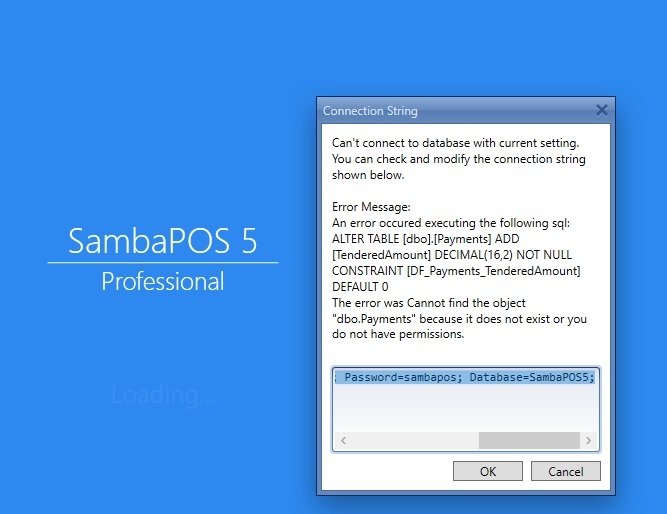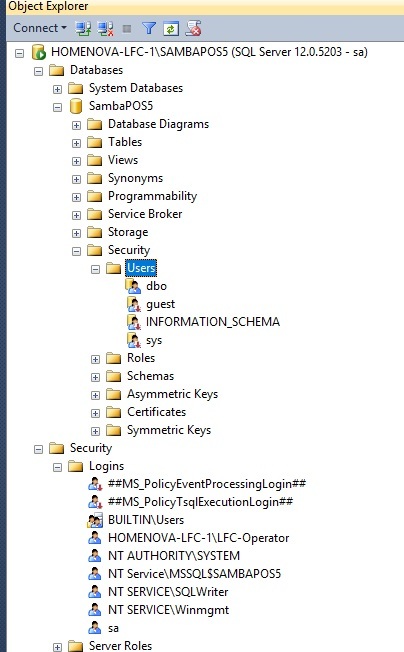Here are the screen shots that I think maybe related
Note the error message seems to indicate there are conflicts in some rules, actions, scripts…or such of the importing of the database

Note that old system is still function without any issue with the rules, actions,…
so I will include the log file here`LFC-Operator said “”
[Exception Info 1]
Top-level Exception
Type: System.Exception
Message: An error occured executing the following sql:
ALTER TABLE [dbo].[Payments] ADD [TenderedAmount] DECIMAL(16,2) NOT NULL CONSTRAINT [DF_Payments_TenderedAmount] DEFAULT 0
The error was Cannot find the object “dbo.Payments” because it does not exist or you do not have permissions.
Source: FluentMigrator.Runner
Stack Trace: at FluentMigrator.Runner.Processors.SqlServer.SqlServerProcessor.ExecuteNonQuery(String sql)
at FluentMigrator.Runner.Processors.SqlServer.SqlServerProcessor.Process(String sql)
at FluentMigrator.Runner.Processors.ProcessorBase.Process(CreateColumnExpression expression)
at FluentMigrator.Expressions.CreateColumnExpression.ExecuteWith(IMigrationProcessor processor)
at FluentMigrator.Runner.MigrationRunner.<>c__DisplayClass1f.b__1c()
at FluentMigrator.Runner.MigrationRunner.AnnounceTime(String message, Action action)
at FluentMigrator.Runner.MigrationRunner.ExecuteExpressions(ICollection1 expressions) at FluentMigrator.Runner.MigrationRunner.ExecuteMigration(IMigration migration, Action2 getExpressions)
at FluentMigrator.Runner.MigrationRunner.ApplyMigrationUp(IMigrationInfo migrationInfo, Boolean useTransaction)
at FluentMigrator.Runner.MigrationRunner.MigrateUp(Boolean useAutomaticTransactionManagement)
at FluentMigrator.Runner.MigrationRunner.MigrateUp()
at FluentMigrator.Runner.Initialization.TaskExecutor.Execute()
at Samba.Persistance.Data.Migrator.DoMigrate(String connectionString)
at Samba.Persistance.Data.Migrator.DoMigrate(CommonDbContext context)
at Samba.Persistance.Data.Initializer.Migrate(CommonDbContext context)
at Samba.Persistance.Data.Initializer.InitializeDatabase(DataContext context)
at System.Data.Entity.Internal.InternalContext.<>c__DisplayClassf1.<CreateInitializationAction>b__e() at System.Data.Entity.Internal.InternalContext.PerformInitializationAction(Action action) at System.Data.Entity.Internal.InternalContext.PerformDatabaseInitialization() at System.Data.Entity.Internal.LazyInternalContext.<InitializeDatabase>b__4(InternalContext c) at System.Data.Entity.Internal.RetryAction1.PerformAction(TInput input)
at System.Data.Entity.Internal.LazyInternalContext.InitializeDatabaseAction(Action`1 action)
at System.Data.Entity.Internal.LazyInternalContext.InitializeDatabase()
at System.Data.Entity.Internal.InternalContext.ForceOSpaceLoadingForKnownEntityTypes()
at System.Data.Entity.DbContext.System.Data.Entity.Infrastructure.IObjectContextAdapter.get_ObjectContext()
at Samba.Infrastructure.Data.SqlData.EFWorkspace…ctor(CommonDbContext context)
at Samba.Persistance.Data.WorkspaceFactory.Create()
at Samba.Presentation.Services.Common.DataGeneration.DataCreationService.get_Workspace()
at Samba.Presentation.Services.Common.DataGeneration.DataCreationService.ShouldCreateData()
at Samba.Presentation.Services.Common.DataGeneration.DataCreationService.CreateData()
at Samba.Presentation.Bootstrapper.InitializeShell()
Inner Exception 1
Type: System.Data.SqlClient.SqlException
Message: Cannot find the object “dbo.Payments” because it does not exist or you do not have permissions.
Source: .Net SqlClient Data Provider
Stack Trace: at System.Data.SqlClient.SqlConnection.OnError(SqlException exception, Boolean breakConnection, Action1 wrapCloseInAction) at System.Data.SqlClient.SqlInternalConnection.OnError(SqlException exception, Boolean breakConnection, Action1 wrapCloseInAction)
at System.Data.SqlClient.TdsParser.ThrowExceptionAndWarning(TdsParserStateObject stateObj, Boolean callerHasConnectionLock, Boolean asyncClose)
at System.Data.SqlClient.TdsParser.TryRun(RunBehavior runBehavior, SqlCommand cmdHandler, SqlDataReader dataStream, BulkCopySimpleResultSet bulkCopyHandler, TdsParserStateObject stateObj, Boolean& dataReady)
at System.Data.SqlClient.SqlCommand.RunExecuteNonQueryTds(String methodName, Boolean async, Int32 timeout, Boolean asyncWrite)
at System.Data.SqlClient.SqlCommand.InternalExecuteNonQuery(TaskCompletionSource`1 completion, String methodName, Boolean sendToPipe, Int32 timeout, Boolean& usedCache, Boolean asyncWrite, Boolean inRetry)
at System.Data.SqlClient.SqlCommand.ExecuteNonQuery()
at FluentMigrator.Runner.Processors.SqlServer.SqlServerProcessor.ExecuteNonQuery(String sql)
[Assembly Info]
mscorlib, Version=4.0.0.0
PresentationFramework, Version=4.0.0.0
PresentationCore, Version=4.0.0.0
System, Version=4.0.0.0
WindowsBase, Version=4.0.0.0
Samba.Services, Version=1.0.0.0
System.ComponentModel.Composition, Version=4.0.0.0
System.Configuration, Version=4.0.0.0
System.Xaml, Version=4.0.0.0
Microsoft.Practices.Prism.MefExtensions, Version=4.0.0.0
Samba.Presentation.Services, Version=1.0.0.0
Samba.Presentation.Common, Version=1.0.0.0
Samba.Domain, Version=1.0.0.0
Microsoft.Practices.Prism, Version=4.0.0.0
System.Core, Version=4.0.0.0
Samba.Infrastructure, Version=1.0.0.0
DevExpress.Xpf.Core.v14.1, Version=14.1.13.0
Microsoft.Practices.ServiceLocation, Version=1.0.0.0
Samba.Localization, Version=1.0.0.0
Samba.Persistance, Version=1.0.0.0
FastButton, Version=1.0.0.0
[System Info]
Operating System
-Microsoft Windows 10 Home
–CodeSet = 1252
–CSDVersion =
–CurrentTimeZone = -240
–FreePhysicalMemory = 1951872
–OSArchitecture = 64-bit
–OSLanguage = 1033
–ServicePackMajorVersion = 0
–ServicePackMinorVersion = 0
–Version = 10.0.14393
Machine
-HOMENOVA-LFC-1
–Manufacturer = LENOVO
–Model = 90FN006NUS
–TotalPhysicalMemory = 4201500672
–UserName = HOMENOVA-LFC-1\LFC-Operator
######################### E N D #########################
[General Info]
Application: SambaPOS
Version: 5.1.62
Region: en
DB: SQ
Machine: HOMENOVA-LFC-1
User: LFC-Operator
Date: 5/15/2017
Time: 8:10 PM
User Explanation:
LFC-Operator said “”
[Exception Info 1]
Top-level Exception
Type: System.Exception
Message: An error occured executing the following sql:
ALTER TABLE [dbo].[Payments] ADD [TenderedAmount] DECIMAL(16,2) NOT NULL CONSTRAINT [DF_Payments_TenderedAmount] DEFAULT 0
The error was Cannot find the object “dbo.Payments” because it does not exist or you do not have permissions.
Source: FluentMigrator.Runner
Stack Trace: at FluentMigrator.Runner.Processors.SqlServer.SqlServerProcessor.ExecuteNonQuery(String sql)
at FluentMigrator.Runner.Processors.SqlServer.SqlServerProcessor.Process(String sql)
at FluentMigrator.Runner.Processors.ProcessorBase.Process(CreateColumnExpression expression)
at FluentMigrator.Expressions.CreateColumnExpression.ExecuteWith(IMigrationProcessor processor)
at FluentMigrator.Runner.MigrationRunner.<>c__DisplayClass1f.b__1c()
at FluentMigrator.Runner.MigrationRunner.AnnounceTime(String message, Action action)
at FluentMigrator.Runner.MigrationRunner.ExecuteExpressions(ICollection1 expressions) at FluentMigrator.Runner.MigrationRunner.ExecuteMigration(IMigration migration, Action2 getExpressions)
at FluentMigrator.Runner.MigrationRunner.ApplyMigrationUp(IMigrationInfo migrationInfo, Boolean useTransaction)
at FluentMigrator.Runner.MigrationRunner.MigrateUp(Boolean useAutomaticTransactionManagement)
at FluentMigrator.Runner.MigrationRunner.MigrateUp()
at FluentMigrator.Runner.Initialization.TaskExecutor.Execute()
at Samba.Persistance.Data.Migrator.DoMigrate(String connectionString)
at Samba.Persistance.Data.Migrator.DoMigrate(CommonDbContext context)
at Samba.Persistance.Data.Initializer.Migrate(CommonDbContext context)
at Samba.Persistance.Data.Initializer.InitializeDatabase(DataContext context)
at System.Data.Entity.Internal.InternalContext.<>c__DisplayClassf1.<CreateInitializationAction>b__e() at System.Data.Entity.Internal.InternalContext.PerformInitializationAction(Action action) at System.Data.Entity.Internal.InternalContext.PerformDatabaseInitialization() at System.Data.Entity.Internal.LazyInternalContext.<InitializeDatabase>b__4(InternalContext c) at System.Data.Entity.Internal.RetryAction1.PerformAction(TInput input)
at System.Data.Entity.Internal.LazyInternalContext.InitializeDatabaseAction(Action`1 action)
at System.Data.Entity.Internal.LazyInternalContext.InitializeDatabase()
at System.Data.Entity.Internal.InternalContext.ForceOSpaceLoadingForKnownEntityTypes()
at System.Data.Entity.DbContext.System.Data.Entity.Infrastructure.IObjectContextAdapter.get_ObjectContext()
at Samba.Infrastructure.Data.SqlData.EFWorkspace…ctor(CommonDbContext context)
at Samba.Persistance.Data.WorkspaceFactory.Create()
at Samba.Presentation.Services.Common.DataGeneration.DataCreationService.get_Workspace()
at Samba.Presentation.Services.Common.DataGeneration.DataCreationService.ShouldCreateData()
at Samba.Presentation.Services.Common.DataGeneration.DataCreationService.CreateData()
at Samba.Presentation.Bootstrapper.InitializeShell()
Inner Exception 1
Type: System.Data.SqlClient.SqlException
Message: Cannot find the object “dbo.Payments” because it does not exist or you do not have permissions.
Source: .Net SqlClient Data Provider
Stack Trace: at System.Data.SqlClient.SqlConnection.OnError(SqlException exception, Boolean breakConnection, Action1 wrapCloseInAction) at System.Data.SqlClient.SqlInternalConnection.OnError(SqlException exception, Boolean breakConnection, Action1 wrapCloseInAction)
at System.Data.SqlClient.TdsParser.ThrowExceptionAndWarning(TdsParserStateObject stateObj, Boolean callerHasConnectionLock, Boolean asyncClose)
at System.Data.SqlClient.TdsParser.TryRun(RunBehavior runBehavior, SqlCommand cmdHandler, SqlDataReader dataStream, BulkCopySimpleResultSet bulkCopyHandler, TdsParserStateObject stateObj, Boolean& dataReady)
at System.Data.SqlClient.SqlCommand.RunExecuteNonQueryTds(String methodName, Boolean async, Int32 timeout, Boolean asyncWrite)
at System.Data.SqlClient.SqlCommand.InternalExecuteNonQuery(TaskCompletionSource`1 completion, String methodName, Boolean sendToPipe, Int32 timeout, Boolean& usedCache, Boolean asyncWrite, Boolean inRetry)
at System.Data.SqlClient.SqlCommand.ExecuteNonQuery()
at FluentMigrator.Runner.Processors.SqlServer.SqlServerProcessor.ExecuteNonQuery(String sql)
[Assembly Info]
mscorlib, Version=4.0.0.0
PresentationFramework, Version=4.0.0.0
PresentationCore, Version=4.0.0.0
System, Version=4.0.0.0
WindowsBase, Version=4.0.0.0
Samba.Services, Version=1.0.0.0
System.ComponentModel.Composition, Version=4.0.0.0
System.Configuration, Version=4.0.0.0
System.Xaml, Version=4.0.0.0
Microsoft.Practices.Prism.MefExtensions, Version=4.0.0.0
Samba.Presentation.Services, Version=1.0.0.0
Samba.Presentation.Common, Version=1.0.0.0
Samba.Domain, Version=1.0.0.0
Microsoft.Practices.Prism, Version=4.0.0.0
System.Core, Version=4.0.0.0
Samba.Infrastructure, Version=1.0.0.0
DevExpress.Xpf.Core.v14.1, Version=14.1.13.0
Microsoft.Practices.ServiceLocation, Version=1.0.0.0
Samba.Localization, Version=1.0.0.0
Samba.Persistance, Version=1.0.0.0
FastButton, Version=1.0.0.0
[System Info]
Operating System
-Microsoft Windows 10 Home
–CodeSet = 1252
–CSDVersion =
–CurrentTimeZone = -240
–FreePhysicalMemory = 1944608
–OSArchitecture = 64-bit
–OSLanguage = 1033
–ServicePackMajorVersion = 0
–ServicePackMinorVersion = 0
–Version = 10.0.14393
Machine
-HOMENOVA-LFC-1
–Manufacturer = LENOVO
–Model = 90FN006NUS
–TotalPhysicalMemory = 4201500672
–UserName = HOMENOVA-LFC-1\LFC-Operator
######################### E N D #########################`
The new db definitions

Where is the text file that contains the settings? I deleted the whole folder \Documents\SambaPOS5 after I uninstall.

